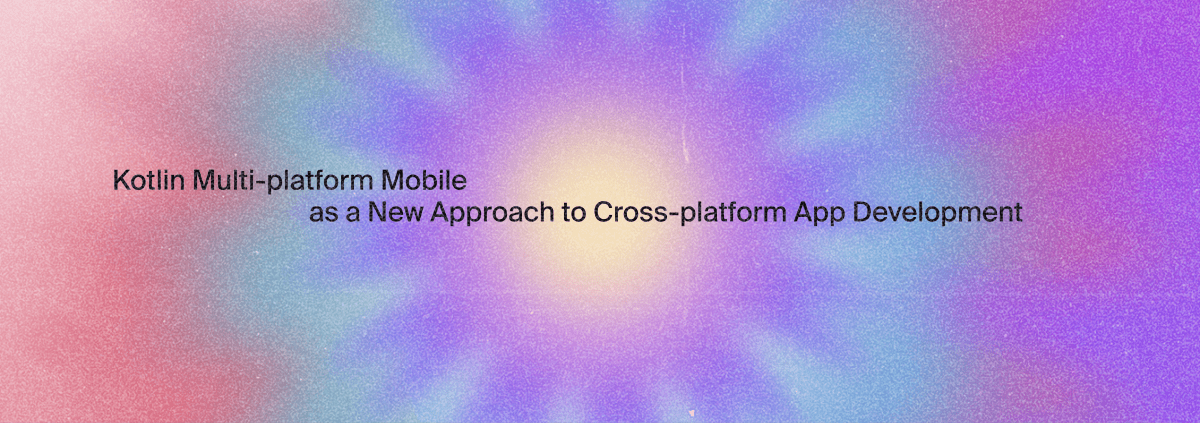Depending on the goals of the future mobile application, you can choose one of two development paths: make two or more native applications or one cross-platform app that is suitable for several platforms at the same time. A cross-platform app is a perfect solution for MVP (Minimum Viable Product) when you have big potential, limited time and a small budget. Another reason to develop a cross-platform mobile app is if your company needs a simple mobile application without complex animations and functions.
To make the cross-platform app development process easier developers all over the world invented special frameworks. Cross-platform app frameworks allow developers to create mobile apps with one-time coding, and without a lot of changes run it on different platforms. Today, there are many good cross-platform frameworks for mobile app development that allow you to create quality applications. Each of them is good for solving a certain problem. In this article, we'll take a closer look at 8 of the most popular cross-platform development frameworks.

1. Flutter
Flutter is one of the youngest cross-platform app frameworks, it was created by Google and released in May 2017. It is a free open-source cross-platform framework, which allows you to develop a mobile application with one array of code. Its distinctive feature is that it uses the Dart programming language, and unlike many cross-platform app frameworks known today, Flutter does not use JavaScript at all.
Thanks to Flutter's Hot-Reload you can modify your code and see the results in real-time. It takes just a few moments to update the app itself. With Flutter, you may build cross-platform mobile apps for iOS, Android, and other less popular mobile platforms. It is worth noting that today this is the only way to create an application for the Fuchsia OS.
Main advantages:
- Mobile applications created with flutter are fast and highly efficient. Using Flutter gives more noticeable performance gains compared to another cross-platform app framework.
- Flutter has its own graphics engine (no need to make the interface separately for Android and iOS).
- Dart allows you to write a much more structured program code, which means you can create more complex applications and hierarchical structures.
More about Flutter.
Developer’s tools:
- Android Studio;
- VS Code;
- Emacs.

2. Xamarin
Xamarin, same as React Native is also a free, open-source cross-platform app framework. It was developed in 2011 as an independent platform but five years later it was acquired by Microsoft.
Xamarin is much different from most cross-platform frameworks. It is based on the open-source implementation of the .NET platform – Mono. This implementation includes its own C# compiler, runtime, and core .NET libraries. The goal of the project is to allow programs written in C# to run on operating systems other than Windows – Unix systems, Mac OS, and others.
This framework consists of several main parts:
- Xamarin.IOS is a C# class library that provides developer access to the iOS SDK.
- Xamarin.Android is a C# class library that provides developer access to the Android SDK.
- Compilers for iOS and Android;
- Xamarin Studio IDE;
- .NET Framework;
- Plugin for Visual Studio.
Main advantages:
- Free and open-source framework.
- Unlike many other cross-platform app development frameworks, Xamarin is pretty easy to use, because it's enough to know C# and .NET environment.
- Has a large community of companies and contributors.
Developer’s tools
- Xamarin Studio;
- Visual Studio Code.

3. NativeScript
NativeScript is an open-source cross-platform framework that allows you to create cross-platform apps using XML, CSS, JavaScript. Besides JavaScript, NativeScript apps are built using any language that transpiles to JavaScript, such as TypeScript, plus it supports AngularJS and Vue.js. NativeScript is suitable for both iOS and Android platforms. Unlike using some other cross-platform frameworks, with Native Script you don't need to install any plugins to access the camera, GPS, etc.
Main advantages:
- NativeScript supports all components from AndroidArsenal and Cocoapods.
- It supports calling native methods from native libraries.
- NativeScript uses a native platform rendering engine instead of WebView, which means it provides a truly native user interface.
- You don't need to know Java or Objective-C to use platform-based APIs because you can write it all in JavaScript.
Developer’s tools
-
CLI NativeScript.

4. PhoneGap
Another amazing cross-platform app development framework is PhoneGap. It was created in 2005 by Nitobi Software which was purchased by Adobe in 2011. PhoneGap is based on JavaScript, HTML5, and CSS3, which makes it very easy to use for web and app developers. Also, it supports a bunch of different platforms from iOS and Android to Windows, Bada, and Blackberry.
It has a powerful back-end system that greatly speeds up the development process. It is best suited for developing simple mobile applications that do not make extensive use of native mobile phone features.
Main advantages:
- Apps developed with PhoneGap show minimal differences on different platforms.
- PhoneGap is powered by JavaScript, HTML5, and CSS3, the most common and very popular web technologies.
- The framework allows you to use embedded payment systems in the app via Google Play Store for Android, App Store for iOS, etc.
- Mobile app developers can use legacy JavaScript or some other libraries like Prototype, jQuery, MooTools, Sencha Touch, and others to manage interaction.

5. React Native
React Native is one of the most well-known cross-platform app development frameworks. It's suitable for both iOS and Android. React Native was created by Facebook Inc. in early 2015 and it's constantly improving by its own community. It's based on React and does not use WebView and HTML technologies. Instead of HTML, there are platform components in JSX, instead of CSS it has CSS-like polyfills. Plus, there is no DOM API. React Native combines the best features of JavaScript and React.JS. Moreover, it gives developers the ability to create some parts using Objective-C, Swift, or Java.
Main advantages:
- Allows creating apps for different platforms Android, Android TV, iOS, macOS, tvOS, Web, Windows, and UWP.
- It is open-source and free thanks to that it has a large community to support and improve it if there are any issues.
- React Native focuses on UI and allows app developers to create a highly responsive interface.
Developer’s tools
- JS editor;
- Xcode and $100 per year per developer account to build and publish apps;
- Android Studio, SDK, Emulator.

6. Ionic
Another open-source cross-platform framework is Ionic. Ionic was made by Max Lynch, Ben Sperry, and Adam Bradley of Drifty Co. in 2013. The original version was released in 2013 and it was built on top of AngularJS and Apache Cordova. Following the Apache Cordova principles, mobile apps created with Ionic Framework are hybrid HTML applications. These kinds of apps run in a special shell on mobile phones (UIWebView for iOS and WebView for Android) that allows you to display HTML and execute JavaScript.
Advantages:
- Knowledge of Angular, HTML, CSS, and JavaScript is all you need to get started developing.
- There're many ready-made UI components available and easy to use.
- Lots of plugins to use native mobile phone features.

7. Node.js
Node.js (or just Node) is a V8-based cross-platform framework that transforms JavaScript from a highly specialized language into a general-purpose language. Node provides a server-side runtime that compiles and runs JavaScript at lightning speed. The V8 engine compiles JavaScript to machine code instead of interpreting it or executing it as bytecode, which makes Node.js really fast.
Advantages:
- The V8 engine is constantly pushing the boundaries and is one of the fastest dynamic language interpreters on the planet.
- With Node.js, you can execute all your database queries at once, reducing response times for slow requests.
- Node.js have a huge community.

8. Solar2D (Corona SDK)
Corona SDK was a very well-known and completely free open-source cross-platform app framework. Unfortunately, Corona SDK is no longer supported, but recently, its developers released a new game framework called Solar2D.
Like its predecessor, Solar2D is a free and open-source cross-platform app framework. It allows you to create mobile games for various devices like iPhones, Android phones and tablets, iPads, Amazon Fire, Desktops, connected TVs, and others.
Advantages:
- Solar2D is based on a Lua scripting language which makes it fast and powerful.
- With Solar2D Native you can call any native (C/C++/Obj-C/Java) library or API.
- Solar2D supports a lot of plugins for in-app advertising, analytics, media, etc.
Conclusion
We hope that the list of the best cross-platform app development frameworks, their descriptions, and the advantages were useful to you. This article will allow you to choose one technology that suits your needs based on its characteristics and the requirements of your project.
If you have the impression that cross-platform applications are only suitable for startups and small companies look at such cross-platform apps as Google Ads, Instagram, Pinterest, Skype, or Wikipedia. However, if you have a complex app development project that demands the latest technical features and complicated animations, then we recommend you to hire one of the top mobile app development companies in New York.





